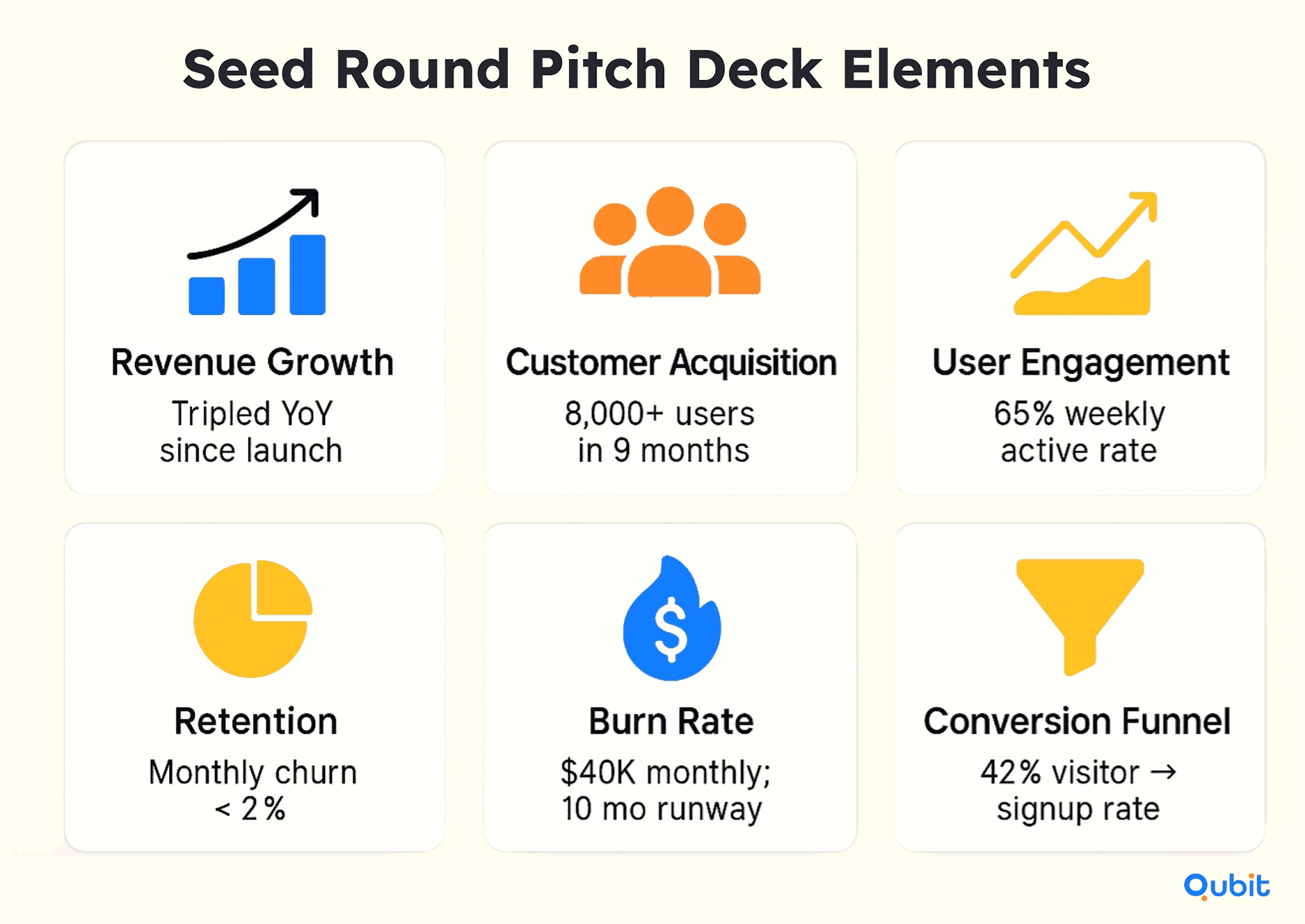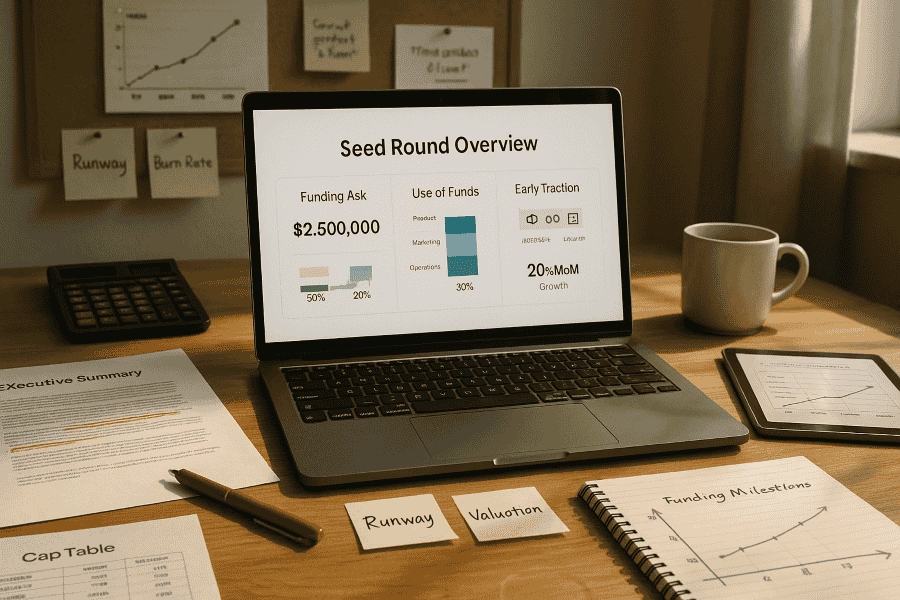Securing early-stage funding begins with a pitch deck that captures attention and communicates your startup’s potential. Investors often spend just 2–5 minutes reviewing these presentations, making it crucial to craft a compelling narrative. A seed round pitch deck is more than a collection of slides. It’s your opportunity to showcase your vision, market opportunity, and growth strategy.
You expand your understanding of presentation structure by examining how to the essentials of pitch deck creation which help to align the funding goals. This blog will guide founders through the essentials of building a pitch deck that resonates with investors, offering actionable insights to secure seed round funding.
How to Create a Winning Seed Round Pitch Deck
Seed investors decide in minutes, so your deck must prove problem, solution, market, traction, and team in under 15 slides. A winning seed-round pitch deck fuses a clear story with crisp metrics and polished design to convert curiosity into commitments. Use the tactics below to structure each slide, avoid rookie pitfalls, and show investors why now is the moment to bet on you.

1. Start with a Clear and Concise Story
Your pitch deck should tell a cohesive story that aligns with your startup's mission and goals. Begin by identifying the problem your business solves and the unique solution you offer. This narrative sets the stage for the rest of the deck, ensuring investors understand your value proposition from the outset.
To refine your storytelling approach, consider referencing resources like the Seed Round Pitch Deck Guide, which provides practical tips for structuring your deck effectively.
2. Highlight Key Metrics
Data-driven insights are essential for building investor confidence. Include metrics that demonstrate your startup's traction, such as revenue growth, customer acquisition rates, or user engagement statistics. These numbers validate your business model and show that your idea is more than just a concept—it’s gaining momentum. Remember, brevity is key. Investors spend limited time on each deck, so focus on the most impactful metrics.
3. Articulate Your Vision
Investors want to know where your startup is headed. Use your pitch deck to paint a vivid picture of your long-term vision, including how your business will evolve and scale over time. This is your opportunity to inspire confidence in your leadership and strategic direction.
When crafting this section, ensure your vision aligns with the problem you’re solving and the market opportunity you’re addressing. A well-articulated vision can differentiate your startup from competitors and make a lasting impression.
4. Showcase Market Opportunity
Demonstrating market potential is critical for securing seed funding. Highlight the size of your target market, growth trends, and any gaps your business can fill. This information reassures investors that your startup has room to thrive and scale.
For additional insights into tailoring your pitch deck for specific audiences, explore pitch deck vs investor deck, which explains how subtle differences can enhance your presentation.
5. Include a Robust Business Plan
Lay out the revenue engines and pricing that will drive cashflow. Map go-to-market stages and resource needs so investors see concrete traction milestones. Detail operational KPIs and a break-even timeline to prove a realistic path to profitability.
Qubit Capital Can Help
Creating a pitch deck that resonates with investors is no small task. At Qubit Capital, we specialize in Pitch Deck Creation services designed to help startups like yours stand out. 👉 Learn more about our services.
Your Go-To Templates and Tools for Pitch Decks
Templates and AI-powered tools offer a practical way to save time while maintaining professional design and consistent branding. Let's see how you can utilize them for your benefit:
Simplify Design with Templates
Templates are a popular choice for startups, with approximately 65% of them using ready-made designs for pitch deck creation. These templates provide a structured framework, ensuring your slides are visually appealing and easy to customize. For example, the Seed Pitch Deck Template is a free, customizable option that allows you to quickly build a polished presentation. If you're seeking inspiration, Seed Stage Pitch Decks offers a curated collection of real-world examples to guide your design process.
Enhance Customization with AI Tools
Use AI-powered deck builders to tailor every slide in seconds. Try Beautiful.ai’s DesignerBot or Canva’s Magic Design to auto-format layouts and brand colors, then refine copy with ChatGPT plugins like AIPRM. Tome or Storydoc can generate narrative flow and visuals from a simple prompt, while Slidebean’s Pitch Deck AI benchmarks your metrics against VC-backed decks. Mix these tools for fast, on-brand customization without sacrificing polish.
Free and Editable Resources
For those on a budget, free resources abound online. Many templates are fully editable, allowing you to align your pitch deck with your brand identity. Whether you're preparing for seed investment or refining your pitch decks for startups, these resources ensure you can focus on crafting compelling content without worrying about design complexities.
You can also enhance your competitive narrative by exploring pitch deck competition slide, where well-articulated design strategies for positioning against competitors are examined.
See How Others Succeeded in Seed Fundraising
Securing seed funding often hinges on the strength of a startup’s pitch deck. By examining real-world examples, founders can uncover strategies that resonate with investors. This section explores how industry leaders like Airbnb and Canva used their pitch decks to highlight unique solutions and market positioning, ultimately securing significant seed capital.
Airbnb: Market Opportunity and Scalability
Airbnb’s pitch deck is a masterclass in showcasing market opportunity and scalability. The company emphasized its ability to solve a pressing problem—providing affordable and unique accommodations—while tapping into a massive market. Their slides clearly outlined the pain points of traditional lodging and positioned Airbnb as the innovative solution.
One standout feature of Airbnb’s deck was its focus on scalability. By presenting a clear growth trajectory and addressing how the platform could expand globally, they captured investor interest.
Canva: Iterative Improvements for Investor Reception
Canva’s journey to seed funding highlights the importance of refining your pitch deck over time. Initially, their deck focused on the simplicity of their design tool, but as they iterated, they incorporated more concrete metrics and user testimonials. This evolution made their pitch increasingly compelling to investors.
What set Canva apart was its ability to balance visionary messaging with actionable data. By continuously improving their deck, they demonstrated adaptability and a deep understanding of investor expectations.
Practical Insights for Structuring Your Deck
Analyzing these examples reveals actionable strategies for crafting your own pitch deck:
- Highlight Unique Solutions: Clearly define the problem your startup solves and how your solution stands out.
- Balance Vision with Metrics: Combine aspirational messaging with data-driven insights to build credibility.
- Prepare for Investor Q&A: Anticipate questions by addressing scalability, market positioning, and financial projections within your slides.
By studying successful pitch decks, founders can gain valuable insights into structuring their own presentations to secure seed funding effectively.
Stay Ahead with These Seed Fundraising Trends
Minimalist design is redefining pitch decks, offering startups a fresh way to communicate their ideas with precision. Simplified slides with clear visuals are gaining traction for their ability to sharpen storytelling and enhance investor focus. Adopting minimalist design ensures that your presentation remains visually appealing while avoiding unnecessary clutter.
Investors are increasingly drawn to pitch decks that prioritize clarity in problem-solution slides. These slides should deliver quick takeaways, making it easier for stakeholders to grasp the core value proposition. A concise narrative paired with impactful visuals can significantly improve engagement during investor meetings.
Another trend shaping 2025 is the growing emphasis on data-driven storytelling. Metrics and data visualization are no longer optional; they are essential tools for building investor confidence. By presenting key metrics in a visually compelling way, startups can substantiate their claims and demonstrate market potential effectively. For advanced techniques, explore the market size slide for pitch deck, which illustrates approaches for presenting key metrics coherently.
As the fundraising landscape evolves, staying ahead of these trends can make all the difference in securing seed funding.
Conclusion
Crafting a compelling seed round pitch deck requires a blend of strategic storytelling and practical insights. By focusing on clear, narrative-driven presentations, startups can effectively showcase their vision, market opportunity, and growth potential. Incorporating templates, case studies, and emerging trends ensures that your pitch resonates with investors and stands out in competitive environments.
Remember, a well-structured pitch deck is not just about presenting data; it’s about creating a narrative that aligns with your startup’s goals and inspires confidence. If you're aiming to secure vital seed funding with a compelling pitch deck, we at Qubit Capital are ready to support you. Our Fundraising Assistance Service can help you secure the investment you need.
Key Takeaways
- A clear, concise narrative keeps investors engaged by guiding them through your vision, problem, and solution without overwhelming detail.
- Incorporate key metrics—such as revenue growth, customer acquisition cost, and churn rate—alongside market opportunity and traction milestones to back up your story with data.
- Utilize proven templates and AI-driven tools to streamline deck creation, enforce consistent branding, and automate formatting tasks so you can focus on content.
- Draw on real-world case studies—highlighting strategies used by successful startups—to gain actionable insights for structuring your slides and reinforcing credibility.
- Stay ahead of emerging trends in minimalist design and advanced data visualization, which are redefining investor expectations and helping presentations stand out.
Frequently asked Questions
What is a seed round pitch deck?
A seed round pitch deck is a concise presentation designed to showcase your startup’s vision, market opportunity, traction, and funding needs to potential investors during early-stage funding.


 Back
Back



